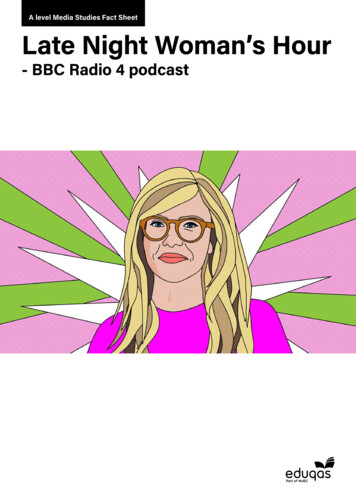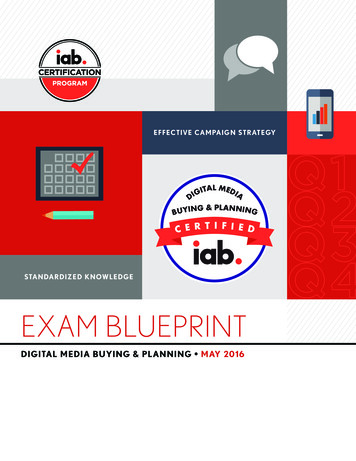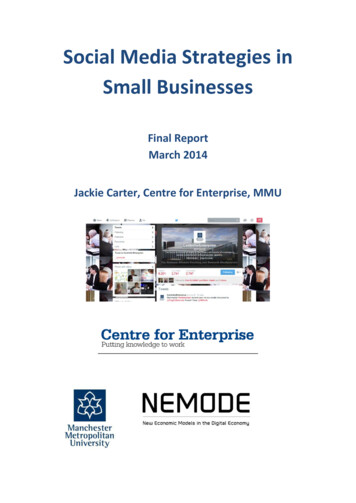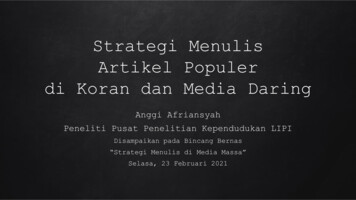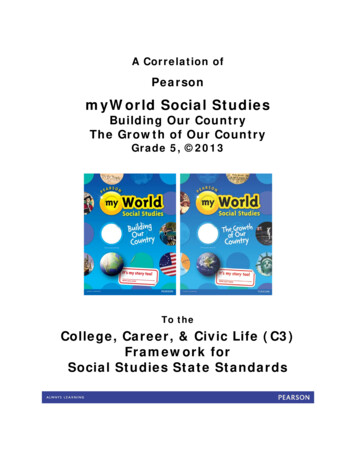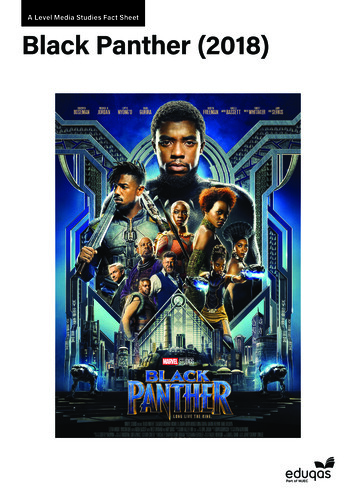
Transcription
A Level Media Studies Fact SheetBlack Panther (2018)
A level Media Studies Fact SheetBlack Panther (2018)AS Component 1:Investigating the MediaA level Component 1: Media Products,Industries and Audiences Focus areas:Media IndustriesMedia ContextsCultural context: PRODUCT CONTEXT Black Panther is the 17th film in the ‘MarvelCinematic Universe’, the highest-grossing filmfranchise in history. It was directed by RyanCoogler (Creed) and released in February 2018. The film shows us the fictional African kingdomof Wakanda, which has avoided Europeancolonisation and achieved a technologicalsuperiority through the use of a mineral calledVibranium. T’Challa (Chadwick Boseman)must fight a number of foes who oppose himbecoming king after the death of his father. Black Panther (T’Challa) first appeared inFantastic Four #62, released July 1966. The film was produced by Marvel Studios,a famous comic book brand that is also asubsidiary of the Walt Disney Company. Black Panther was extremely successful, brokerecords for the highest opening weekend inthe USA, and also performed well globally.The film has grossed well over 1 billionworldwide, with 48% in non-US countries. It was also one of the only superhero films tobe nominated for a ‘Best Picture’ AcademyAward. It won three Oscars for Costume,Production Design, and Original Soundtrack. PART 1: STARTING POINTS – Media IndustriesHistorical Context: The Black Panther Party (October 1966-82)was a political activist group establishedinitially to provide armed monitoring of policebehaviour and prevent police brutality in the US.It was controversial, with many Panthers beingarrested or killed in confrontations with police. From 15th-20th century, European powerscolonised African countries and exploited thecontinent for both resources and slave labour.Africans were branded ‘savages’ by the Europeaninvaders, their cultures dismissed as ‘primitive’.During the early 20th century, AfricanAmericans attempted to establish a newblack cultural identity with movementssuch as the Harlem Renaissance.The science fiction blockbuster and superherogenres have traditionally been dominated bywhite, male characters. In the 1990s, actors likeWill Smith and Wesley Snipes did break groundplaying black characters, but recent actionfilms and especially superhero films have rarelyfeatured African-American actors in lead roles.For the last 15 years, Marvel films have toppedthe box office. Though these regularly featurednon-white characters, they were often sidekicks(e.g. The Falcon in the Captain America films).There have also been very few superherofilms with a female lead (Wonder Womanand Captain Marvel being exceptions).Black cinema has traditionally consisted ofissues-based social realism (e.g. the films ofSpike Lee) or have been ‘arthouse’/’prestige’pictures (e.g. Moonlight, 2016). Blade(1998) is one of the few superhero filmsto have a black main character.In 2016, the #oscarssowhite meme drew attentionto the lack of diversity in the films nominated.US/European news media tends to portray Africaas an under-priviliged, developing country,focusing on civil wars, famine and terrorism.The Victorian branding of Africa as ‘the DarkContinent’ has not evolved very far. Very fewfeature films from Africa reach the Westernmainstream, and films like Blood Diamond(2006) and Captain Phillips (2013), thoughfeaturing sympathetic African characters, stillportray Africa as a dangerous and barbaric place.Further study: research the cultural movementof ‘Afrofuturism’. What does this term mean?How have artists explored the idea in music,art, film and other media? To what extentis Black Panther an Afrofuturist film?Economic and Political Contexts: 1Barack Obama (2009-2017), America’sfirst African-American president, createdmany initiatives that aided minority
A level Media Studies Fact Sheet and women’s groups: from universalhealthcare, to college and entrepreneurshipaccess funds for the under-priviliged.Donald Trump, the current president, has vowedto reverse many of these, winning supportfrom mostly white, right wing Americans whoconsider such initiatives unfair. In addition,Trump has insulted other countries (includingmany in Africa), and refused to condemnviolent racist attacks in American cities.Worrying statistics about the amount ofunarmed ‘people of colour’ (POC) shot byUS police led to the #blacklivesmattercampaign, which has utilised social mediato raise awareness of an issue that has oftenbeen ignored by mainstream media. Consider the significance of patternsof ownership and control, includingconglomerate ownership, verticalintegration and diversification: Black Panther was produced by Marvel Studios,who became a subsidiary of Disney in 2008.They are also the film’s distributor, which makesthis a good example of vertical integration.Marvel has historically sold options onindividual characters or comicbook titles e.g.Spiderman to TV and then to Paramount (andwho is still partly owned by Sony). BlackPanther was one of those owned fully byMarvel; in 2009 a new team began developingT’Challa and lesser known characters.In early 2000s, Marvel Studios beganto produce films, starting with Blade(1998) and the X-Men films (2000).When Disney bought Marvel, they agreed tominimal creative influence over Marvel products.in 2013, Marvel also signed a deal withstreaming service Netflix to develop TV seriesfor six more characters (including Daredevil andPunisher who had already been made into films).This may have caused conflict with Disney,who has their own streaming channel, and in2019 Netflix cancelled their Marvel shows. Consider how media organisations maintain,including through marketing, varietiesof audiences nationally and globally: Disney, the film’s distributor adopteda ‘360-degree consumer experience’to their marketing (i.e. wherever youlook, there’s Black Panther!)The concept was to make the film into 2a ‘cultural event’ across a variety ofmedia and platforms and raising its profilefrom being ‘another superhero’ film intosomething more politically resonant.Here are some of the brand association dealsDisney used to target a diverse audience whomay not be ‘fanboys’. How do these a.) appeal toa different spectator than other Marvel films?:Hasbro toys ercial-is-moreimportanttha-1821802836 ; Lexus cars lack-panther-ahead-of-sema-2017-300542095.html Interscope records (Universal er-kendrick-lamar-black-panther/ andb.) how do they combine in a synergy to makeBlack Panther ‘more’ than a superhero film?Black Panther’s teaser trailers wereshown between NBA games and a specialcollaboration with Lexus called ‘LongLive The King’ was shown during theSuperbowl. What kind of audiences normallywatch these programmes? How are theydifferent to the usual Marvel fanbase?The film’s release also harnessed a politicalelement to add gravitas. Crowd-funding projectsto buy under-privileged children a ticket wonsupport from celebrities; the film was releasedduring Black History Month; plus Coogler, thestars and the costume , hair/make-up , productiondesigners all gave detailed interviews about howthe film celebrates African culture. d-of-black-panther/553157/There was also a ‘Welcome to Wakanda’ catwalkshow at New York Fashion Week and featuresin numerous fashion magazines. (On openingweekend 44% of ticket buyers were female)Look at the preview posters and thetrailer - (https://www.youtube.com/watch?v xjDjIWPwcPU) - how does the filmcelebrate African culture? Why might it beimportant to black children to have characterslike Black Panther? How does it also representblack women in a powerful way? How doesit also appeal to fans of blockbusters?Disney are adept at identifying nuanceddemographic groups and strategies for targetingthem. Many of their products are ‘intercultural’i.e. they strongly represent one cultural tradition
A level Media Studies Fact Sheet but in a way that resonates with audiences fromother cultural / national / ethnic backgrounds.Disney has used recent Nielsen researchto challenge conventional ideas about theethnic diversity in mainstream America.53% of Americans live in a multiculturalor ‘blended’ household. 67% indicated theywere enthusiastic about encountering andexperimenting with ‘diverse cultures’.Think about recent Disney releases like Moana(2016) or Coco (2017): how do they represent acultural tradition positively? What universalthemes or story elements would audiencesnot from that culture still engage with?than 5 million tweets globally. In midMarch 2018, it became the most-tweetedabout film ever with 35 million tweets.Consider how film/film marketingis circulated and distributed: Consider the regulatory framework ofcontemporary media in the UK and therole of regulation in global production,distribution and circulation: The BBFC (an independent, non-governmentalbody) classifies film and video releases in theUK. However, local councils have the powerto overrule BBFC decisions and rate filmsdifferently (e.g. This is England was rated 18by the BBFC but several councils rated it 15).The theatrical release of Black Panthergained a 12a certificate. Look at the BBFCwebsite for what constitutes a 12a - whydo you think they awarded this to BlackPanther? (http://www.bbfc.co.uk/)The film, like many recent Marvel films,features very little romantic drama and no sexor nudity. It is fairly violent, but the combat isfantastical (hard to imitate) and there is a strongmoral code to most of the conflict. The filmwas classified as PG-13 in USA, and similarlyin other territories. Why do you think the filmwas regulated this way, even in countries withstricter rules and censorship like China or India? Theoretical perspectives:A level only:Cultural industries – David Hesmondhalgh Consider processes of production,distribution and circulation and the impactof digitally convergent platforms: Where and how is film/film marketing mostlikely to be consumed by audiences?How has this consumption changed/been impacted by the internet, includingYouTube and smartphones?Are audiences now more likely to seekout, for example, new trailers online asactive consumers? (Think about ‘reaction’videos of people watching trailers!)Consider the way people share trailersor movie gossip (casting decisions, plotelements etc.) especially those with astrong fan community. How is this is anexample of ‘word-of- mouth’ marketing.How does this impact the relationshipbetween audience and product?How did Black Panther harness other,more political social media campaignsto create a ‘cultural event’ rather thanjust another summer blockbuster? The teaser trailer was released in June 2017by Disney’s sister channel ABC, duringNBA Finals. Within 24 hours it had beenviewed 89 million times on Youtube.Just before release, Black Panther was themost-tweeted about film of 2018 with more3Further explore the concept of profit in relationto the film industry and in this case specificallyto the film franchises. Often films within aseries can become formulaic and lack risk. Isthis the case with Marvel Studios? Or Disney?Explore Hesmondhalgh’s idea that mediaconglomerates operate across a range of culturalindustries by considering the way the film wasreleased as part of a synergy - with fashion,music, videogames, sports tie-ins, even a car!You might also usefully introduce the idea thatthis film has a very low risk for the producers.The character of T’Challa and Wakanda wereintroduced in Captain America: Civil War, thecomic is over 50 years old, and all previousMarvel films have been hugely successful. Onthe other hand, having such an Afrocentric
film could have been seen as a commercialrisk, especially outside the USA and Africa. Curran and Seaton ‐ Media and power How does the film’s much celebrated diversitychallenge Curran and Seaton’s idea thatdomination by a small number of mediainstitutions limits creativity and variety?How could the conglomerate model4(Marvel as a separate brand to Disney)offer a more complex pattern of ownershipthan Curran and Seaton describe?To what extent does the dominance ofMarvel in the sci-fi/superhero genre limittheopportunities for alternative, riskierindependent films in these genres?
Black Panther (2018) AS Component 1: Investigating the Media . The science fiction blockbuster and superhero genres have traditionally been dominated by white, male characters. In the 1990s, actors like . stars and

